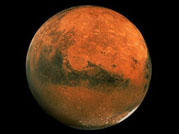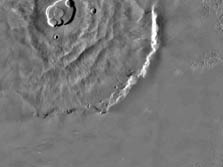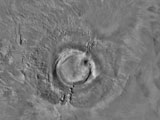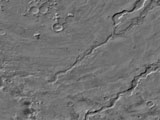




Possible Habitats for Life on Mars
|
Present
theories about life on Mars suggest that if it exists it will
be microbial in nature and most probably nano-bacterial
or archaean. There is almost
no credence given to any ideas that Martian life will be any more
complex than this. Good evidence that perhaps Martian life
exists or at least, exited a long time ago has come from analysis
of Martian meteorites, as well as the
detailed examinations of the planet that have been carried out
by the series of spacecraft that have
visited. Potentially, Mars offers some suitable habitats for extremophile life. In addition, there are numerous places where life may at one time have been able to flourish. Such places include:
|
|
Hot springs
Olympus Mons is the largest volcano in the Solar System. On its south slope orbiting spacecraft have found a hot-spot, that may indicate the presence of a hot water springs. This may now be dry, but perhaps in the past it was active.
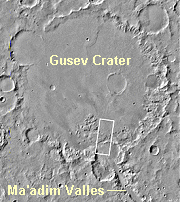
Dry lake bedsGustav crater resembles a dry lake bed. In this view a canyon on its south side has been identified as a place where water has collect. It is dry now by in the past such a place may have supported life.
|
Large volcanoes are present on Mars, but all these are inactive, and have been for a long time. On Earth microbes have been found associated with undersea volcanic vents. Similar structure may exist on Mars, but again they may be long extinct. That does not rule out the possibility of finding fossils or even dormant microbes in such structures. On Earth these structures are comparatively small and the same may be true of Mars. No definite identification of such structures have so far been found, but they may show up, as the high resolution images from the current and future missions are analyzed. This image shows Arsia Mons. |
|
River
valleys |
 Ocean
basins There is one place however, where something more permanent may have existed, and that is in the bottom of the Valles Marineris, the great rift in Mars' surface. Here a small ocean may just have existed for something more than a fleeting moment in Mars history. |
![]()
Exploring
Mars - geology
Life on
Mars I
Life on Mars
II
Life
on Mars III
Hot
springs on Mars
The
case for liquid water on Mars
Alkaline
Hyper saline Lakes as Analogs for Ancient Microbial Habitats on Mars
Mars
-- Martians
Biological
Potential of Mars
Mars Exploration
Go
to
Home
| Space Station
| Mars | Rainforest
© 1999 Satellite Events Enterprises Inc.
